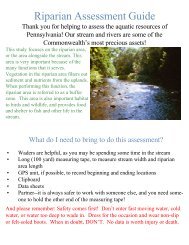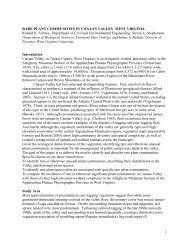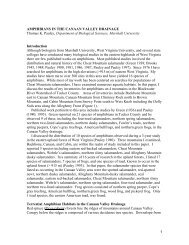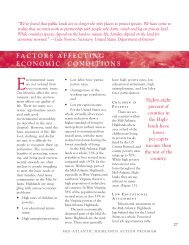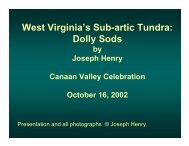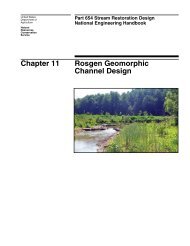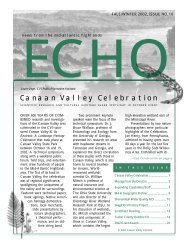1 PREHISTORY OF CANAAN VALLEY: AN ECOLOGICAL VIEW ...
1 PREHISTORY OF CANAAN VALLEY: AN ECOLOGICAL VIEW ...
1 PREHISTORY OF CANAAN VALLEY: AN ECOLOGICAL VIEW ...
You also want an ePaper? Increase the reach of your titles
YUMPU automatically turns print PDFs into web optimized ePapers that Google loves.
How many native North Americans were living in 1491? Estimates range widely,<br />
from 900 thousand to 18 million (Verano and Ubelaker 1991), in part because many died<br />
before a first estimate was possible. The indigenous genome conferred little resistance to<br />
some Old World diseases like smallpox, measles, cholera, diphtheria, typhoid fever, and<br />
influenza (Horse Capture 1991). Swift hemisphere-wide pandemics started at points of<br />
contact with the first explorers and traders. Native populations were reduced by 50-90%<br />
(Viola 1991) and cultural systems profoundly changed (Henderson 1992) before literate<br />
observers arrived (Diamond 1998).<br />
Historic Period (350 YBP-present)<br />
Before 300 YBP, aboriginal people appear to have abandoned most of West Virginia.<br />
Although several reasons for this hiatus have been offered, such as the holocaust from<br />
infections, depopulation by the Iroquois Confederacy, and westward displacement by<br />
aggressive Europeans, the causes remain a mystery.<br />
Trails<br />
The rapid spread of Paleo-Indian fluted points, Archaic atlatls, Woodland horticulture,<br />
and pathogens was presumably facilitated by a network of trails (Haynes 1996) (Fig. 2).<br />
Via trails, people of the western Mid-Atlantic participated in a larger cultural sphere that<br />
shared ideas, tools, and other cultural elements (Gardner 1984). In a heavily dissected<br />
region with a dendritic drainage pattern, like the Canaan Valley area, travel occurred<br />
along ridges and stream bottoms (Bush 1996). [The Native American trail system is the<br />
basis of our mountain highway system (Sullivan and Prezzno 2001c).] The resulting<br />
cultural diffusion contributed to a regional identity (Sullivan and Prezzano 2001c).<br />
Facilitated by trails, prehistoric people of the Mid-Atlantic uplands participated in<br />
an extensive trade network that reached from the east coast to the Rocky Mountains and<br />
from the Great Lakes to the Gulf of Mexico. Valued rocks, like cherts from Ohio, flints<br />
from Illinois, and obsidian from Yellowstone, were passed hand to hand, from one band<br />
to another, over hundreds, even thousands, of miles. Other trade items included mica<br />
from North Carolina, copper from the Great Lakes, and mollusk shells from the Gulf of<br />
Mexico. All of these items have been found at prehistoric sites within the cultural sphere<br />
that includes Canaan Valley.<br />
A dominant path, known as the Great Warrior Trail, extended along the grain of the<br />
Appalachians from New York to Alabama (Sullivan and Prezzano 2001a). Probably<br />
functioning by 5,000 YBP, this well-worn route enabled the movement of commodities,<br />
people, and ideas (Watson 2001).<br />
Projectile points from all prehistoric periods have been recovered from West<br />
Virginia and adjacent areas (Lesser 1993). Because its artifact assemblages reflect<br />
cultural influences from the Ohio Valley, the northeast, and the southeast, the Mid-<br />
Atlantic uplands appear to have been a melting pot of the prehistoric cultures of eastern<br />
North America.<br />
Therefore, because North America was criss-crossed by trails, which presumably<br />
facilitated the movement of people, valued items, and ideas over vast distances, the<br />
prehistoric people of the Canaan Valley area were part of the regional, even continental,<br />
cultural trends that characterized the major prehistoric periods.<br />
5





